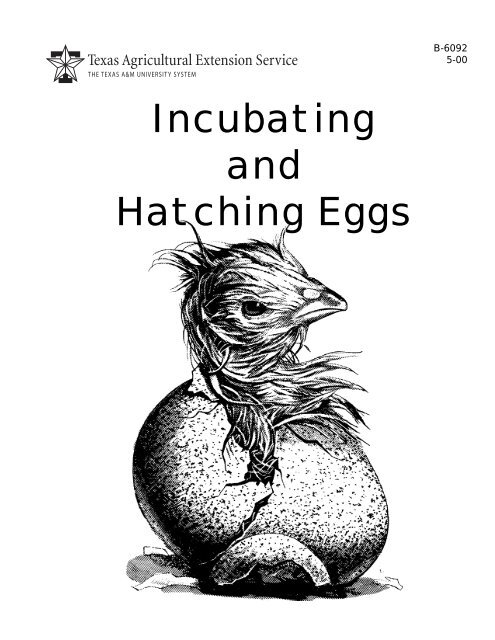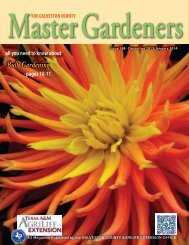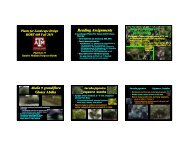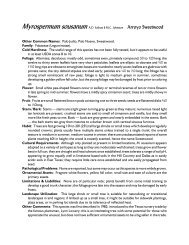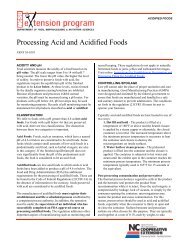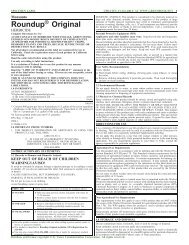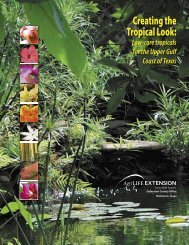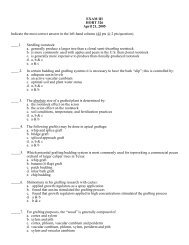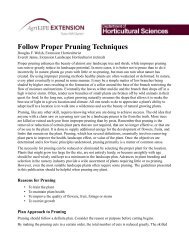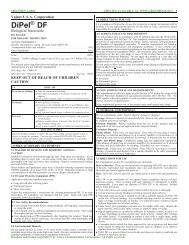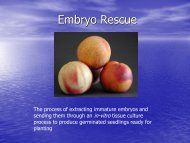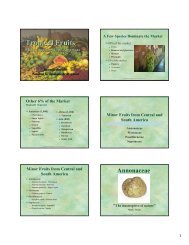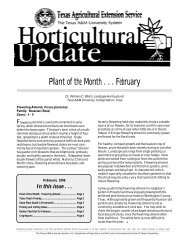Incubating and Hatching Eggs - Aggie Horticulture - Texas A&M ...
Incubating and Hatching Eggs - Aggie Horticulture - Texas A&M ...
Incubating and Hatching Eggs - Aggie Horticulture - Texas A&M ...
Create successful ePaper yourself
Turn your PDF publications into a flip-book with our unique Google optimized e-Paper software.
B-60925-00<strong>Incubating</strong><strong>and</strong><strong>Hatching</strong> <strong>Eggs</strong>
<strong>Incubating</strong> <strong>and</strong> <strong>Hatching</strong> <strong>Eggs</strong>A. Lee Cartwright*<strong>Eggs</strong> of exotic birds <strong>and</strong> commonchickens require a st<strong>and</strong>ard measureof care in storage <strong>and</strong> incubation toensure a successful hatch. Environmentalconditions, h<strong>and</strong>ling, sanitation <strong>and</strong> recordkeeping can impact the success of incubating<strong>and</strong> hatching eggs.Fertile Egg QualityFrom the smallest canary eggs to thelargest ostrich eggs, high quality fertile eggsshould always be considered rare <strong>and</strong> fragile.To successfully hatch eggs, begin with fresh,clean, fertile eggs.<strong>Eggs</strong> can be produced “on site” or purchasedfrom many sources. Commercialhatcheries will ensure good fertility, but oftenwill not ship small quantities of eggs.<strong>Eggs</strong> easily transmit contagious diseasesbetween flocks. Therefore, to ensureprotection from such diseases, purchaseeggs from only National Poultry ImprovementPlan (NPIP) or equivalent surveyedfacilities. Every egg producer should beNPIP tested; further information can beobtained from <strong>Texas</strong> A&M University NPIPat (979) 845-4186.If eggs are purchased by mail order, it isimportant to ensure that the eggs receiveproper care in transit. Extremes of temperature<strong>and</strong> poor h<strong>and</strong>ling can destroy prospectsfor a good hatch.If fertile eggs are produced “on site” at thebusiness location, the breeding stock must bemaintained <strong>and</strong> supported for maximumhealth <strong>and</strong> fertility. Basic egg production isseverely affected by day length <strong>and</strong> lightingcontrol. Egg quality <strong>and</strong> embryo livability areaffected by hen <strong>and</strong> sire age, health, nutrition,cock/hen ratio, breeder genetics, <strong>and</strong>other factors that can stress birds such as theweather. Keeping more than four females permale can reduce fertility in some settings.Inbreeding, the mating of closely relatedmales <strong>and</strong> females, might decrease fertility ofeggs <strong>and</strong> increase embryo mortality. Hatchabilityof eggs is severely harmed by inbreeding,age <strong>and</strong> poor health.* Extension Poultry Specialist, The <strong>Texas</strong> A&M UniversitySystem.Most eggs are laid by mid-morning. <strong>Eggs</strong>should be collected several times a day toreduce the amount of time eggs remain in thenest. This practice decreases the number ofcracked <strong>and</strong> soiled eggs <strong>and</strong> also preventspremature incubation. Embryos begin toprematurely develop at temperatures above72 degrees F. Starting <strong>and</strong> stopping embryodevelopment by repeatedly changing temperaturesincreases embryo death. Frequentcollection <strong>and</strong> proper storage delays embryodevelopment until egg incubation can begin.Storing Fertile <strong>Eggs</strong>Fertile eggs are alive. Each egg contains aliving cell mass that develops into an embryo,<strong>and</strong> finally into a chick. Each incidenceof improper h<strong>and</strong>ling reduces the probabilityof a successful hatch. Fertile eggs usually aregathered over a period of time before anadequate number of eggs can accumulate forincubation, or until the incubator is availablefor a new set of eggs. These normal situationsrequire that, before incubation, eggs must bestored properly to ensure hatchability.Cleaning <strong>and</strong> culling—Cracked, poorlyshaped, soiled <strong>and</strong> unusually large or smalleggs should not be incubated. These eggsrarely hatch <strong>and</strong> they increase the probabilityof introducing infection into the incubator.<strong>Eggs</strong> should not be washed. Washing orwiping with a damp cloth removes a protectivelayer that coats the egg. Soiled eggsshould be cleaned by gently buffing thesoiled area with fine s<strong>and</strong>paper. Washingeggs transfers disease infection agents fromthe surface to the inside of the eggs.If an egg is washed, it should be washedbriefly in 110-degree F water that contains acommercial egg sanitizer. Washing an egg inwater that is cooler than the egg itself causesegg contents to contract. Contraction of eggcontents draws water into the egg throughpores in the shell. This water carries infectingmicroorganisms into the egg.General care—After clean <strong>and</strong> undamagedeggs have been selected for incubation,use great care to prevent damage or contaminationof the eggshells. This includes usingfrequent h<strong>and</strong> washing as a barrier to microbialcontamination.
Storage time—Ideally, eggs should be setin the incubator as soon after gathering aspossible to maintain egg quality. If eggs areto be stored before incubation, the besthatchability occurs when eggs are stored forless than 7 days from the time they were laid.However, some species are more sensitive tostorage than other species. Hatchabilitydecreases rapidly in eggs held in storage formore than 10 days. Storing eggs longer than2 weeks also can extend the normal incubationtime as much as 1 day.Temperature <strong>and</strong> humidity duringstorage—Fertile eggs should be stored at adry bulb, normal temperature between 55degrees F <strong>and</strong> 65 degrees F, or 13 degrees C<strong>and</strong> 18 degrees C. Embryos will begin todevelop abnormally, weaken <strong>and</strong> die if thetemperature is too high. A low temperaturealso causes high embryo mortality. Storagetemperature should never exceed 72 degreesF (22 degrees C) <strong>and</strong> never go below 46degrees F (8 degrees C). Egg storage at roomtemperature or at normal refrigerator temperatures(32 degrees F to 40 degrees F) is notacceptable because hatchability decreases.A refrigerator can be used to store eggs ifthe temperature is properly adjusted to therecommended temperatures. <strong>Eggs</strong> should bestored in a refrigerator dedicated to eggstorage because these temperatures are notlow enough to safely store food. Storagetemperature should be reduced to 50 degreesF or 55 degrees F if eggs must be stored morethan 2 weeks.Holding eggs for more than 10 daysreduces hatchability. However, chukar <strong>and</strong>turkey eggs are an exception. Chukar eggshave been stored 3 weeks to 4 weeks withoutappreciable loss in hatchability.A good storage area also requires stablehumidity. Two methods, wet bulb temperature<strong>and</strong> relative humidity, are measures ofhumidity. These two methods should not beconfused; whenever humidity measures arediscussed, know which method is referenced.Relative humidity is the water vapor inthe air expressed as a percentage of thegreatest amount of water vapor possible atthat temperature. The amounts of watervapor that air can contain are different atdifferent temperatures. To measure relativehumidity, expensive equipment or a complicatedprocedure is required. However, thewet bulb temperature is easily measured <strong>and</strong>is the method usually used to measurehumidity in an incubator. Relative humidityis expressed as a percentage while wet bulbtemperature is expressed as degrees.A wet bulb thermometer can be purchasedor made from a common dry thermometer.Knowing how to make a wet bulb thermometerhelps to underst<strong>and</strong> how it works. Athermometer, a shoelace (approximately a 6-inch long piece) <strong>and</strong> a short piece of dentalfloss are needed. First, stick the bulb end ofthe thermometer about 1 inch into the hollowof the shoelace. Next, tie a piece of dentalfloss around both the shoelace <strong>and</strong> thermometerdirectly above the bulb. This is to keepthe shoelace from sliding off. Place theopposite end of the shoelace directly in a panof water. If the water is the same temperatureas the air temperature, the reading on thethermometer is the wet bulb temperature.The temperature reading of the wet bulb willbe less than a dry thermometer becauseevaporation of water cools the thermometer.However, the reading also will be influencedby the relative humidity of the air. Thewet bulb reading is used as an index ofrelative humidity but is not numericallyequal to the relative humidity value. The wetbulb temperature will change at different drybulb temperatures even as the relativehumidity remains constant. So, the appropriatewet bulb temperature that is to be maintainedmust be known for each dry bulbtemperature that occurs during storage.Relative humidity in the storage roomshould be approximately 70 percent to 80percent (wet bulb temperature of 50 degreesF to 60 degrees F). Condensation forms oneggshells exposed to excessive humidity.Condensation on the eggshell can clog pores<strong>and</strong>, like washing eggs, provides a vehicle forcontamination. Suffocation or contaminationof the embryo can result. Excessive amountsof water evaporate from the egg if humidityis too low, which also causes embryo death.To increase the humidity, a pan of water canbe placed in the storage room. If the incubatortemperature is correct, the only factorgoverning humidity is the surface area ofwater inside the incubator or storage unit.Avoid drafts during storage that can dry eggseven when humidity levels are withinappropriate levels.Hatchability is best maintained by storingeggs with the small end down in sealed,airtight plastic bags. The bags help keep theeggs clean <strong>and</strong> prevent moisture loss.2
Positioning <strong>and</strong> turning eggs duringstorage—<strong>Eggs</strong> that will be stored for lessthan 10 days before incubation should beplaced on egg flats or in egg cartons withthe large end up. <strong>Eggs</strong> do not need to beturned from side to side during storage ifthey are incubated within the week theeggs are laid. If the eggs are not sealed in aplastic bag, cover them with a loose fittingmaterial to prevent debris or dust fromsoiling the eggs.<strong>Eggs</strong> stored for more than 10 days shouldbe tilted from side to side over a 90-degreeangle once or twice a day to assure optimalhatching success rates. To turn eggs duringthe holding period, place a 6-inch blockunder one end of the carton (or flat) holdingthe eggs to produce a 45-degree angle againstthe floor. The next day, remove the block <strong>and</strong>place it under the opposite end of the carton.Turning eggs prevents some hatchability lossthat can occur during long-term storage.IncubationWhen an adequate number of eggs arecollected, move eggs from storage to incubation.Incubators—Incubators of several types<strong>and</strong> capacities with adapters for eggs fromdifferent species are available. Basically, anincubator is a box that holds <strong>and</strong> rotates eggswhile maintaining appropriate temperature,humidity <strong>and</strong> oxygen levels. A well-designedincubator should maintain temperaturewithin 1/4 degree F <strong>and</strong> humidity within 1degree F wet bulb temperature.Several features are st<strong>and</strong>ard in popular orlarger incubator models. Automatic turnersthat turn eggs at least once every 2 hours to 4hours are recommended. Humidifiers are ofseveral types. Some are actuated by wet bulbsystems while others are designed to maintainhumidity by a simple water reservoirsurface area system. Either of these systemscan be used effectively. Temperature can becontrolled by the older wafer system or bynewer microprocessor systems. Whatever thesystem chosen, an incubator with a backupcontroller set at less than 102 degrees F cansave the hatch if the primary temperaturecontroller ever malfunctions. Remember thattemperature, humidity, ventilation <strong>and</strong>turning are the important factors duringincubation.Egg Storage Reminders✰ Store less than 10 days.✰ Maintain temperature between 55 degrees to 65 degrees F.✰ Keep relative humidity at 75 percent (50 to 60 degrees F wetbulb temperature).✰ Turn eggs stored more than a week.✰ H<strong>and</strong>le the eggs with care!Consider the differences between forceddraft<strong>and</strong> still air incubators before choosing asystem to use. Forced-draft incubators maintainmore consistent temperature <strong>and</strong> humiditylevels throughout the incubator, <strong>and</strong>recover temperature <strong>and</strong> humidity to regulatedlevels faster when doors are openedduring the incubation period. In still airincubators, wet bulb readings are misleading<strong>and</strong> a water reservoir with a large surfacearea is needed. Temperatures in still air incubatorsmust be monitored at the level of theeggs since temperature can vary considerablybetween locations within a still air incubator.Forced-draft incubators are preferred.The temperature <strong>and</strong> humidity of the roomhousing the incubator should be controlled<strong>and</strong> stable. Place the incubator in a stableenvironment, free of drafts <strong>and</strong> away fromdirect sunlight.Locate the incubator <strong>and</strong> hatcher awayfrom growing facilities. The equipment <strong>and</strong>newly hatched chicks can be contaminated byolder birds, <strong>and</strong> the dust that accompaniesgrowing birds. Keep foot traffic to a minimum;personnel should limit trips betweenthe growing area <strong>and</strong> the incubation area asmuch as possible. Do this by attending to theincubator <strong>and</strong> hatchlings before maintainingother areas.Chicks can be hatched in the same unit inwhich they were incubated. However, hatchingcreates large amounts of dust <strong>and</strong> down.<strong>Hatching</strong> in a separate unit prevents contaminating<strong>and</strong> soiling the incubator. Temperature<strong>and</strong> humidity also can be managed moreeffectively if separate units are used forincubation <strong>and</strong> hatching. It is best to keephatchers in a separate room from the incubator.The incubator <strong>and</strong> the hatchers should beconstructed <strong>and</strong> coated with material that iseasily sanitized. The incubation <strong>and</strong> hatcherrooms should also be constructed or coatedwith impermeable material that can be easilywashed <strong>and</strong> sanitized.3
Table 1. Total incubation time to hatch, time for transfer to hatcher, <strong>and</strong> dry <strong>and</strong> wet bulbtemperatures for common birds.Common Name Incubation Conditions Hatcher ConditionsPeriod Dry Bulb Wet Bulb Transfer Dry Bulb Wet Bulb(days) (° F) (° F) at day (° F) (° F)Canary 13-14 100.5 86-88 11 99 90-94Chicken 21 99.5 86 18 98.5 90-94Cockatiel 18-20 99.5 86-88 15-18 99 90-94Cockatoo (various) 22-30 99.5 86-88 20-27 99 90-94Conure (Sun) 28 99.5 86-88 25 99 90-94Conure (various) 21-30 99.5 86-88 18-27 99 90-94Dove 14 99.5 86 12 98.5 90-94Duck (common) 28 99.5 86-88 25 98.5 90-94Muscovy Duck 35-37 99.5 86-88 31-33 98.5 90-94Finch (Zebra) 14 99.5 86-88 12 99 90-94Domestic Goose 30 99.5 88 27 98.5 90-94Geese (various) 22-30 99.5 88 20-27 98.5 90-94Grouse 24-25 99.5 84-86 22 99 90-94Guinea 28 99.5 84-86 25 98.5 90-94Lovebird (various) 22-25 99.5 86-88 20-22 99 90-94Macaw (various) 26-28 99.5 86-88 23-25 99 90-94Mynah 14 100.5 86-88 12 99 90-94Parakeet (various) 18-26 99.5 86-88 15-23 99 90-94Budgerigar 18 99.5 86-88 15 99 90-94Parrot (various) 18-28 99.5 86-88 15-25 99 90-94Parrot (African Grey) 28 99.5 86-88 25 99 90-94Chukar Partridge 23-24 99.5 88 20 99 90-94Peafowl 28-29 99.5 86-88 25-26 98.5 90-94Ptarmigan 21-23 99.5 86-88 18-20 99 90-94Raven 20-21 99.5 86-88 17-18 99 90-94Ring-neck Pheasant 24-25 99.5 86-88 21 99 92-95Pheasant (various) 22-28 99.5 86-88 20-25 99 92-95Pigeon 17-19 100.5 88 14 99 92-95Bobwhite Quail 23 99.5 84-86 21 99 90-94Japanese Quail 17-18 99.5 86-88 15 99 90-94Swan (various) 33-37 99.5 86-88 30-33 99 90-94Turkey 28 99.5 84-86 25 98.5 90-94Emu 49-50 97.5 70-75 47 97.5 90Ostrich 42 97.5 70-75 39 97.5 90Rhea 36-42 97.5 80 97.5 901This period is the entire incubation time until hatch that includes 3 days in the hatcher. Ventilation should be increased halfway through the incubation period.5
If the humidity in the incubator is too highduring incubation, too little water willevaporate from the egg. The air cell will betoo small for the chick to reach during thehatching process. The chick will either drownor the chick will be too swollen with water toturn itself within the egg. The yolk sac willalso be too large for the navel to completelyclose. These problems will cause the hatch tofail.The air cell of the egg should becomelarger as incubation progresses. Chicken eggswill lose 12 percent to 14 percent of their totalweight by evaporation during incubation.The growth of this air cell is a balancebetween temperature <strong>and</strong> humidity duringthe incubation. Racks of eggs can be weighedduring incubation to detect problems withhumidity <strong>and</strong> evaporative loss before a hatchis destroyed.The chick embryo uses oxygen <strong>and</strong>produces carbon dioxide. This gas exchangeis insignificant during the early period ofincubation or when a small number of eggsare incubated. However, recommendations ofthe incubator manufacturer should befollowed to assure that adequate oxygen isavailable to the developing chicks. Near theend of the incubation period, the eggs arenearly filled with the embryo. An incubatorfilled with eggs contains a large animal massthat requires large amounts of oxygen.Adequate ventilation is needed during theend of the incubation period. Particularattention should be focused on air ventsettings, <strong>and</strong> wet <strong>and</strong> dry bulb temperaturesduring the last third of incubation.Record keeping—Keep a daily record ofthe incubator environment (Appendix A).This sample record is designed for use witheggs that hatch after 21 days of incubation.Record keeping can be used to detect malfunctionsbefore a disaster develops. Also,records of fertility <strong>and</strong> embryo deaths alertthe hatchery manager to production, storage,or incubator problems so that adjustmentscan be corrected before major losses occur.Proper records call attention to deviationsthat could destroy a producer’s profits. A 5percent loss of hatchability can go unnoticed.However, a 5 percent loss is 100 percentprofit, <strong>and</strong> conditions that cause a 5 percentreduction in hatchability also contribute tohealth problems in successfully hatchedchicks.C<strong>and</strong>lingAll incubated eggs will not hatch. It isprobable that only 90 percent or less ofincubated eggs are fertile. Removal of eggsthat can be identified as infertile or deadeliminates possible sources of contaminationfrom the incubator. C<strong>and</strong>ling can be used toidentify some of these eggs.Shining a light through the egg to observeembryo development is called “c<strong>and</strong>ling.”White or pale eggs are more easily c<strong>and</strong>ledthan dark or speckled eggs. Many people usesmall flashlights with lenses the size of anickel that can be focused to c<strong>and</strong>le eggs.Excellent c<strong>and</strong>lers also can be purchased at areasonable cost. Simple c<strong>and</strong>ling devices canbe made by inserting a light into a container<strong>and</strong> cutting a small hole to emit light, or bytaping a cone formed from several thicknessesof paper over the lens of a bright lightprojector. The hole that allows light to passfrom the tip of the cone should be the size ofa dime or quarter (depending upon the sizeof the egg).In a dark room, hold the egg to the light ofthe c<strong>and</strong>ler to observe the contents of theegg. Cooling that occurs for short periods(less than 10 minutes) during careful examinationof eggs does not harm the developmentof the embryo. However, limit theexposure of the egg to the hot light source.Even a brief period at 104 degrees F kills allembryos.The presence of embryos can be confirmedeasily after 8 days to 12 days of incubation.The embryo is located in the large end of theegg, where blood vessels radiate under thesurface of the shell. The embryo appears as adark spot that becomes larger as incubationprogresses. Eventually only a dark mass <strong>and</strong>the air cell are seen. An infertile orunincubated egg brightly transmits light incomparison. Remove infertile or nongrowingeggs from the incubator. If questions ariseabout c<strong>and</strong>ling, contact someone withexperience for advice.Dead embryos will sometimes appear as aring or smear of blood in the egg or a darkspot dried to the inside of the shell. Theliving embryo will appear as a dark spot inthe large end of the egg surrounded by afaint outline of blood vessels. The bloodvessels will appear firm <strong>and</strong> distinct. Afterembryo death, the embryo no longer grows<strong>and</strong> the blood system fades.6
Retain records of egg infertility or embryodeath. Some mortality can be expected,however, unusual occurrences of mortality orcertain characteristics of the mortality can beindicators of practices that can be correctedto improve hatchability.Hatch StageThe hatch stage refers to the final 2 days to3 days of incubation. Chicks hatch out of theshell during this stage. Do not turn the eggsduring the last 3 days to 4 days of incubation.Transfer eggs to a dedicated hatcher at thistime. If a hatcher is unavailable, remove theeggs from the turner <strong>and</strong> lay the eggs in thehatching basket or place on cloth or roughpaper (not newspaper) in the incubator.Make sure that the paper does not obstructairflow, contact the water, or contact theheating element. Temperature should remainat 99.5 degrees F <strong>and</strong> increase the humidityto at least 90 degrees F wet bulb. Humiditycan be increased by adding either a wetsponge or wet paper towels to increase theevaporative surface in the incubator. Thechicks should start to pip within a day of theincubation period listed for the species inTable 1.When Chicks HatchThe hatching process requires greatexertion by the chick. The chick progressesthrough periods of activity followed bylengthy periods of rest. The entire hatchingprocess requires 10 hours to 20 hours. Do notbe concerned about the time a specific chickrequires to hatch unless the process exceeds20 hours.Once chicks successfully leave the shellthey should remain in the incubator untiltheir feathers are dry. Ventilation should beincreased. When more than 90 percent of thechicks are dry they should be removed fromthe hatcher. Excessive time in the incubatorcan dehydrate chicks. Remove chicks to awarm brooder <strong>and</strong> provide them with water<strong>and</strong> feed.<strong>Eggs</strong> that remain unhatched for 1 daybeyond the predicted incubation periodshould be discarded. Attempts to help achick free itself from the shell often areunsuccessful. Chicks too weak to hatchthemselves usually do not live. If they live,they usually will not thrive. Dispose of weakor deformed chicks humanely. These chicks✰✰✰Incubation RemindersLocate the incubator in a room with a constant temperature,away from drafts <strong>and</strong> direct sunlight.Sanitize the incubator.Ensure that the humidifier <strong>and</strong> wet bulb wick are in workingorder.✰ Wash h<strong>and</strong>s before touching eggs. Keep germs, dirt <strong>and</strong> oilaway from incubating eggs.✰ Only incubate egg species with similar incubation lengths atthe same time in one incubator.✰ The small end of the egg should not be higher than the largeend.✰ Keep a daily record of incubator data.✰ Check temperature daily <strong>and</strong> keep it at 99.5 degrees F to 100degrees F.✰ Verify that the water trough is full <strong>and</strong> humidity measures86 degrees F to 88 degrees F wet bulb.✰ Turn eggs at least five times a day until the last 3 days beforehatch.✰ Increase ventilation during the last one-third of the incubationperiod.✰ Do not turn for the final 3 days. Provide a cloth or roughpaper surface upon which chicks can walk.✰ Increase wet bulb to 90 degrees F in the hatcher.should never be used for breeding purposesbecause these traits could be transmittedgenetically to their young.Embryo Mortality (Death)Unsuccessful hatches can be caused byinfertile eggs or embryo mortality. Each ofthese conditions can be diagnosed afterc<strong>and</strong>ling <strong>and</strong> after hatch. Examine eggs thatdo not hatch to estimate whether infertility orembryo death is the basis for hatch failure.Keep records of the time of embryo death;such records can suggest changes in husb<strong>and</strong>rythat can increase profitability. Asample record form for hatch <strong>and</strong> fertilityfailures is in Appendix B.Embryo death predominately occurs attwo periods during incubation: within thefirst 3 days of incubation <strong>and</strong> within the last3 days immediately before a hatch.Early embryo death occurs during formationof embryonic organs. Of all the eggsdetermined to be fertile by c<strong>and</strong>ling at onethirdof incubation, 88 percent to 93 percentshould continue to develop.7
Death immediately before a hatch occursduring the transition betweenliving in an egg to living on theoutside. The chick can have difficultypositioning for pipping,absorbing the yolk sac, orchanging to breathing air.Sometimes humidity controlcan be implicated in some ofthese problems. An overall hatchof more than 85 percent to 90percent can be achieved.Collect <strong>and</strong> examine all unhatchedeggs to determine the cause of hatchfailure. An appropriately developedchick within the egg will showcertain characteristics. Normallythe head is under the right wing.The air cell will be large enough toallow the chick to position correctlyfor hatching. The shell membranesshould not dry to the chick during hatch.Note any dryness. Note the condition of thebeak, wings <strong>and</strong> legs for proper form. Allabnormalities should be recorded <strong>and</strong>analyzed to determine if hatch failure resultedfrom fertility or environmental problemsthat can be corrected by changingmanagement procedures. Nutrition can be afactor in fertility <strong>and</strong> hatchability problems,as recognized by the National ResearchCouncil (Appendix C).Examine the eggs that fail to hatch byremoving the top of the egg at the large end.Carefully examine the contents <strong>and</strong> classifyinfertile or dead embryos using the designationslisted in Table 2.Use the “Hatchability <strong>and</strong> MortalityRecord” (Appendix B) to calculate thepercentage fertility, percentage hatchability<strong>and</strong> percentage of total eggs hatched. Thesenumbers will help in evaluating hatchefficiency. Any change in these figures, or achange in the distribution in mortalityrecords are early warnings to correct smallproblems before they become serious.Table 2. <strong>Incubating</strong> <strong>and</strong> <strong>Hatching</strong> Egg <strong>and</strong> Chick Classification.Culled eggsInfertile eggsEarly deadMiddle deadLate deadMalformedMalpositionedLive pipsDead pipsRotsCulled chicksGood chicksCracked, misshapen or otherwise not likely to hatch.Determined to have no germ. Originally infertile. These eggs are clear during c<strong>and</strong>ling<strong>and</strong> show no evidence of blood or embryo development.Embryos died during the first quarter of incubation. Some of these can be detected<strong>and</strong> removed during c<strong>and</strong>ling. These eggs would be fertile <strong>and</strong> could show a deadearly embryo, show no development, development but no blood, or a blood ring.Embryos died after the “early” period but before transfer.Embryos died during the hatch phase of incubation.Embryos that have an obvious deformity.Embryos not positioned correctly for hatching.Chicks that have pipped <strong>and</strong> are living, but not hatched.Pipped chicks that died but are not malformed or malpositioned.Infected or contaminated eggs.Chicks that hatched but are unsound.Good quality, healthy normal chicks.Table 3. Possible Causes of <strong>Hatching</strong> ProblemsObservation<strong>Eggs</strong> ExplodingNo embryonic developmentPossible CausesDirty eggsImproperly cleaned eggsDirty incubatorInfertile eggRough h<strong>and</strong>ling of eggsIncubation temperature too highIncubation temperature too low<strong>Eggs</strong> stored too long8
Table 3. Possible Causes of <strong>Hatching</strong> Problems (continued)ObservationNo embryonic developmentBloodringEarly deadDead embryos, second weekAir cell too smallAir cell too largeChicks hatch earlyDry chicksBloody navelsChicks too smallChicks hatch lateChicks dead after pipping shellUnhealed navelMushy or water-logged chicksMalformed legs <strong>and</strong> toesWeak chicksGasping chicksMalpositionsPossible Causes<strong>Eggs</strong> stored improperlyBreeders stressedToo many hens per roosterOld or unhealthy hens or malesInbreedingDiseaseOld eggsIncubation temperature too highIncubation temperature too lowIncubation temperature too highIncubation temperature too lowElectric power failure<strong>Eggs</strong> not turnedInbreedingInfectionPoor nutrition of breedersHumidity too highHumidity too lowSmall eggsTemperature too highHumidity too lowLarge eggsOld eggsTemperature too lowHumidity too high<strong>Eggs</strong> not turned first 2 weeksThin-shelled eggsIncorrect temperature during incubationTemperature too high during incubationHumidity too high during incubationHumidity too low during incubationInfection, diseaseTemperature too low during incubationWide temperature variation in incubatorHumidity too high during incubationPoor ventilationImproper temperature during incubationImproper humidity during incubationLegs also may be harmed by hatching or holding chicks on a smooth surfaceTemperature too high or lowOld eggsPoor ventilationDiseaseBronchitisNewcastle diseaseTemperature too high or lowTurning inadequateLarge end of egg not up when setOld or poorly h<strong>and</strong>led eggsPoor breeder nutrition9
APPENDIX A: INCUBATOR DATA CHARTTurner Works 1 Temperature Wet WaterDay # Date 1 2 3 Room Incubator Bulb Checked C<strong>and</strong>ling Remarks12345678910111213141516171819 XXX XXX XXX20 XXX XXX XXX21 XXX XXX XXXThis record is important. Keeping data will help prevent problems from developing during incubation.1Check the turner three times each day except days 19 through 21. <strong>Eggs</strong> are not turned on these days.10
APPENDIX B: Hatchability <strong>and</strong> Mortality RecordSet C<strong>and</strong>ling <strong>Eggs</strong> Dead Malformed/ Pips Chicks PercentageID # Date Date Culled Infertile Early Middle Late Malposition Live/Dead Rots Cull Good Fertility 1 Hatch 2 Total 3/ // // // // // // // // // // // /This record is important. Keeping data will help identify problems with bird husb<strong>and</strong>ry <strong>and</strong> incubation.1 Fertility (%) = (Fertile <strong>Eggs</strong>/<strong>Eggs</strong> Set) x 100%.2 Hatchability (%) = (Good Chicks Hatched/Fertile <strong>Eggs</strong>) x 100%.3 Total <strong>Eggs</strong> Hatched (%) = (Good Chicks Hatched/<strong>Eggs</strong> Set) x 100%.11
Nutrient:Vitamin AVitamin DVitamin EVitamin KThiaminAppendix C: Signs of Deficiency in the EmbryoDeficiency Signs:Death at about 48 hours of incubation from failure to develop the circulatory system; abnormalitiesof kidneys, eyes <strong>and</strong> skeletonDeath at about 18 or 19 days of incubation, with malpositions, soft bones, <strong>and</strong> with a defectiveupper m<strong>and</strong>ible prominent.Early death at about 84 to 96 hours of incubation, with hemorrhaging <strong>and</strong> circulatory failure(implicated with selenium).No physical deformities from a simple deficiency, nor can they be provoked by antivitamins, butmortality occurs between 18 days <strong>and</strong> hatching, with variable hemorrhaging.High embryonic mortality during emergence but no obvious symptoms other than polyneuritis inthose that survive.Riboflavin (Vitamin B 2)NiacinBiotinPantothenic acidPyridoxineFolic acidVitamin B 12ManganeseZincCopperIodineIronSeleniumMortality peaks at 60 hours, 14 days, <strong>and</strong> 20 days of incubation, with peaks prominent early asdeficiency becomes severe. Altered limb <strong>and</strong> m<strong>and</strong>ible development, dwarfism <strong>and</strong> clubbing ofdown are defects expressed by embryo.Embryo readily synthesizes sufficient niacin from tryptophan. Various bone <strong>and</strong> beak malformationsoccur when certain antagonists are administered during incubation.High death rate at 19 days to 21 days of incubation, parrot beak, chondrodystrophy, severalskeletal deformities <strong>and</strong> webbing between the toes. Perosis.Deaths appear around 14 days of incubation, although marginal levels may delay problems untilemergence. Variable subcutaneous hemorrhaging <strong>and</strong> edema; wirey down in poults.Early embryonic mortality based on antivitamin use.Mortality at about 20 days of incubation. The dead generally appear normal, but many havebent tibiotarsus, syndactyly <strong>and</strong> m<strong>and</strong>ible malformations. In poults, mortality at 26 days to 28days of incubation with abnormalities of extremities <strong>and</strong> circulatory system.Mortality at about 20 days of incubation, with atrophy of legs, edema, hemorrhaging, fattyorgans, <strong>and</strong> head between thighs malposition.Deaths peak prior to emergence. Chondrodystrophy, dwarfism, long bone shortening, headmalformations, edema, <strong>and</strong> abnormal feathering are prominent. Perosis.Deaths prior to emergence, <strong>and</strong> the appearance of rumplessness, depletion of vertebral column,eyes underdeveloped <strong>and</strong> limbs missing.Deaths at early blood stage with no malformations.Prolongation of hatching time, reduced thyroid size, <strong>and</strong> incomplete abdominal closure.Low hematocrit; low blood hemoglobin; poor extra-embryonic circulation in c<strong>and</strong>led eggs.High incidence of dead embryos early in incubation.12
ResourcesPublicationsMullin, J.M. <strong>and</strong> P.M. Boehmer. Gamebird Propagation. Wildlife Harvest Publications,Inc., 2000.<strong>Hatching</strong> Manual. Lyon Electric Company, Inc., 1988.Stromberg, Janet. A Guide to Better <strong>Hatching</strong>. Stromberg Publishing Company, 1975.Circular 530, “<strong>Incubating</strong> <strong>Eggs</strong> of Domestic Birds.” Cooperative Extension Service,Clemson University.B-1123, “Care, Management, Propagation - Japanese Quail (Coturnix).” <strong>Texas</strong> AgriculturalExtension Service.Leaflet No. 519, “Raising Guinea Fowl.” U.S. Department of Agriculture, U.S. GovernmentPrinting Office.Circular 514, “Raising Bobwhite Quail for Commercial Use.” Cooperative ExtensionService, Clemson University.Leaflet 21046, “Raising Game Birds.” Division of Agricultural Sciences, University ofCalifornia.Leaflet 21321, “Raising Chukar Partridges.” Department of Avian Sciences, Universityof California.Bulletin 878, “Game Bird Production <strong>and</strong> Health.” The Cooperative ExtensionService, University of Georgia.Wall chartsCherms, F.L. “Embryonic Mortality of Turkey Wall Chart,” Nicholas Turkey BreedingFarms, Inc., Sonoma, Calif.“Embryo Development Chart,” Jamesway Incubator Co., Monroe, N.C.Poster 21559, “The Australian Emu: Embryonic Development,” ANR CommunicationServices, University of California. http://anrcatalog.ucdavis.edu.Poster 3321, “Development of the Pheasant Embryo,” ANR Communication Services,University of California. http://anrcatalog.ucdavis.edu.VideoV86-W, “<strong>Hatching</strong> Egg Breakout Video,” ANR Communication Services, University ofCalifornia. http://anrcatalog.ucdavis.edu.
For more information about sources <strong>and</strong> suppliers of incubators <strong>and</strong> supplementalequipment, contact the local office of the <strong>Texas</strong> Agricultural ExtensionService or contact Lee Cartwright in the Poultry Science Department, 107 KlebergCenter, 2472 TAMU, College Station, TX 77843-2472, telephone (979) 845-4319,fax (979) 845-1921, e-mail a-cartwright@.tamu.eduProduced by Agricultural Communications, The <strong>Texas</strong> A&M University SystemExtension publications can be found on the Web at: http://texaserc.tamu.eduEducational programs of the <strong>Texas</strong> Agricultural Extension Service are open to all people without regard to race, color, sex, disability, religion, age or national origin.Issued in furtherance of Cooperative Extension Work in Agriculture <strong>and</strong> Home Economics, Acts of Congress of May 8, 1914, as amended, <strong>and</strong> June 30, 1914,in cooperation with the United States Department of Agriculture. Chester P. Fehlis, Deputy Director, <strong>Texas</strong> Agricultural Extension Service, The <strong>Texas</strong> A&MUniversity System.2,000, New PS 3


